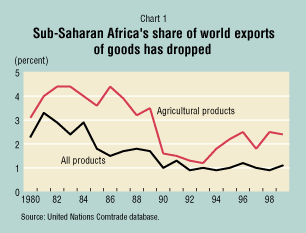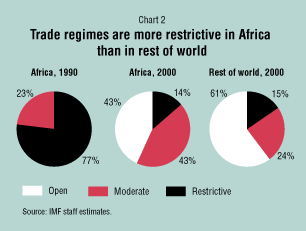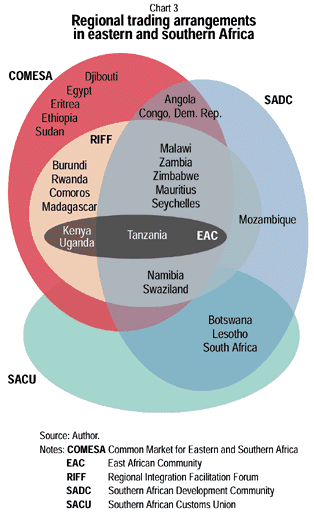 About F&D Subscribe Back Issues Write Us Copyright Information |
An Agenda for Trade, Investment, and Regional Integration Robert Sharer
The importance of enhancing sub-Saharan Africa's trade performance, which was very weak in the 1980s and 1990s, cannot be overemphasized (Chart 1). Africa's non-oil exports in 2000 came to about $69 billion. If Africa had retained its share of non-oil world exports at 1980 levels, exports in 2000 would have been $161 billion, or $92 billion more than their actual level. Even if Africa had held its market shares at 1980 levels only for those commodities it already exported in substantial quantities in 1980, such as coffee, tea, and cocoa, exports would now be some $62 billion a year higher. By contrast, the total cost of the Heavily Indebted Poor Countries Initiative is about $30 billion—to be delivered over more than twenty years—and the most recent replenishment of the World Bank's concessional lending arm, the International Development Association, totaled $22 billion for a three-year period.  Without a substantial improvement in its trade performance, Africa will be unable to reverse its weak growth performance of the past two decades, and it is only by achieving sustainable high-quality growth that it will be able to meet its overarching goal of improving the living standards of the majority of its population. Trade has been a major engine of growth in the industrial countries and the middle-income developing countries, and extensive studies have consistently shown that export growth is linked to economic growth. Moreover, there is growing empirical evidence that improved trade performance is closely associated with increased employment opportunities and income for the poor. The causes of Africa's weak trade performance are complex. Fundamental are the region's lack of infrastructure and physical and human capital, as well as factors outside Africa's control, such as limited natural endowments and a difficult geographic location. But flawed policies also play an important role. A country's ability to improve its trade performance in the short run is determined mainly by its macroeconomic and structural policies. Trade and growth prospects are enhanced by a macroeconomic framework that emphasizes appropriate fiscal and monetary policies conducive to price stability, saving and investment, and a sustainable external current account position. These factors are critical in maintaining a stable economic environment and, thus, in encouraging productive activities. Trade policy and liberalization Over the past decade, Africa has made substantial progress in liberalizing trade. In 1990, more than 75 percent of the countries in the region had trade regimes classified as "restrictive," as measured by the IMF's Index of Aggregate Trade Restrictiveness (Appendix I of a 1998 IMF study, Trade Liberalization in IMF-Supported Programs), and none had trade regimes that could be classified as open. Since the early 1990s, many of these countries have adopted ambitious structural adjustment programs, which have included substantial efforts at trade reform. Only 14 percent of African countries' trade regimes are now classified as restrictive, while 43 percent are classified as open. Nevertheless, on average, the trade regimes of African countries remain significantly more protectionist than those of other countries, including Africa's major trading partners (Chart 2). Sixty-one percent of countries outside Africa have trade regimes classified as open. All the industrial countries, which account for more than two-thirds of Africa's trade, maintain open trade regimes. Despite its tariff reductions during the past decade, Africa's current average tariff of about 19 percent is still higher than the average of 12 percent for the rest of the world. The average tariff of the industrial countries is around 5 percent and their nontariff barriers are very low—except for agricultural products and textiles—helping to ensure the efficiency of these economies and the competitiveness of their goods and services on international markets. The African economies are therefore at a significant disadvantage, compared with their trading partners and competitors.  A liberal trade regime is almost invariably linked to a country's ability to attract foreign direct investment and promote trade. Complex, opaque trade rules and regulations—particularly those that entail considerable administrative discretion and offer favorable treatment to select groups of producers and consumers—are anathema to good governance, transparency, and the creation of a level playing field, all of which are essential to efficient foreign and domestic investment. Market access A global environment that offered Africa trade and investment opportunities in the sectors in which the region has a comparative advantage would also create a strong incentive for African countries to undertake reforms. However, the industrial countries' current agricultural trade policies and trade preferences are more likely to act as disincentives. First, industrial country protectionism in the agriculture sector is particularly harmful to Africa, much of whose export potential is in agricultural products and processing. Although, overall, the trade regimes of the European Union, the United States, and other industrial countries are open, agriculture is a major exception. (Protection in textiles also remains significant but is being gradually phased out in accordance with the Uruguay Round of multilateral trade agreements.) Tariffs on agricultural raw materials in the European Union (EU) average 5 percent, and those for processed agricultural goods average more than 10 percent, while the average EU tariff on other goods is only about 2 percent. These figures understate the true level of protection, however, because tariffs in the European Union are low or zero on agricultural products that the European Union does not produce and much higher on imports that might compete with domestic products. The tariff structure of the United States is similar. Furthermore, significant escalation is built into the European Union's tariff structure, which discourages imports of higher-value-added processed products from Africa. The industrial countries have also erected many nontariff barriers—in the form of price supports, subsidies, and special marketing arrangements—that keep out agricultural products from Africa. Product standards and health regulations can also be used for restrictive purposes. Thus, it is clearly in Africa's interest to support broad-based multilateral liberalization of agriculture in the next round of global trade negotiations. Second, while industrial countries have been according trade preferences to developing countries for many years, studies have found little evidence that these preferences have increased African trade. There are several reasons for this. First, the margin of preferences is small for most products, and preference margins are falling as industrial countries liberalize their trade. Second, access to industrial country markets is often restricted by complex rules of origin and other administrative requirements that are difficult for African exporters to satisfy. Third, most preferences may be removed at the discretion of industrial country authorities, depending on the level of imports. Thus, preferences are surrounded by uncertainty, which discourages long-term investment in the production of goods subject to them. Most important, middle-income countries have reaped most of the benefits of preferences. For example, in 1996, Brazil, India, Indonesia, Malaysia, the Philippines, and Thailand accounted for 75 percent of all U.S. imports benefiting from preferences. The industrial countries could support Africa's efforts to benefit from globalization through enhanced trade by adopting more broad-based preferences geared to the region's needs. In this respect, a proposal of potentially major benefit to Africa, initially made at the Group of Seven summit in Lyon in 1996 by Renato Ruggiero, World Trade Organization (WTO) Director General at that time, and subsequently endorsed by the Managing Director of the IMF and the President of the World Bank, calls for exports from the poorest countries to be granted across-the-board, bound, duty-free, and quota-free access to industrial country markets. Gaining open access to industrial country markets on a more permanent basis would significantly enhance trade incentives for Africa. Unlike the present system of preferences, bound duty-free access would create a stable environment and thus boost investor confidence. African countries will need to undertake complementary reforms—including opening their own markets—if they wish to take advantage of the new market opportunities. There have recently been very favorable developments in improving market access to industrial country markets along these lines. The United States's African Growth and Opportunity Act improves Africa's access to U.S. markets, albeit in limited circumstances for a limited number of goods. More important, the EU Council recently adopted the "Everything But Arms" proposal for duty- and quota-free access for all products from the least developed countries, except for 25 tariff lines related to the arms trade and some temporary restrictions on bananas, rice, and sugar. (Restrictions will be removed gradually for bananas (by 2006) and sugar and rice (by 2009).) To make more substantive, widespread, and permanent gains in market access, it would be highly beneficial if the EU scheme were adopted by other major industrial countries and eventually bound in the World Trade Organization in the next round of international trade negotiations. Although it is inevitable that the major trading countries will have more power in the global trading system than African countries, the latter should explore ways to increase their bargaining power to ensure that the key issues affecting them are adequately addressed—for example, by joining forces around areas of common interest and concern. African countries make up 29 percent—and sub-Saharan African countries, 26 percent—of the membership of the WTO. This is a substantial bloc, and a way should be found to effectively use it to make gains in a few key areas. Regional integration Regional integration is another major potential source of enhanced trade and investment, economic efficiency, and growth generally. In sub-Saharan Africa, some regional trade arrangements have contributed significantly to structural reform by creating incentives for removing restrictive trade practices and licensing procedures, streamlining customs procedures and regulations, integrating financial markets, simplifying transfers and payments procedures, and harmonizing tax treatment. In a few instances, countries have gone even further, seeking to harmonize investment incentives, standards, and technical regulations, as well as policies relating to transportation, infrastructure, labor, and immigration. The benefits such reforms provide to regional partners spill over into more efficient and equitable treatment of all trading partners and thus contribute to a more favorable economic environment, including for investment. The importance of regionalism in stimulating efficiency and reforms should not be underestimated. However, it is not a substitute for broad-based liberalization vis-à-vis Africa's major trading partners. If not accompanied by a broadly similar degree of external trade reform, regional trade arrangements cause inefficient trade diversion to more expensive imports from regional partners. The creation of trade within the region would offset the costs of trade diversion only if the degree of intraregional trade were high. However, in sharp contrast to Europe and North America, this is not the case in Africa, where intraregional trade accounts for less than 10 percent of total trade. Regional trade agreements, if not accompanied by broad-based external liberalization and a common external tariff, also undermine the efficiency of tax systems. Another problem with regional trade arrangements that is especially acute in eastern and southern Africa is the number of overlapping and internally inconsistent initiatives. The various regional groupings—including the Regional Integration Facilitation Forum (successor to the Cross-Border Initiative), the Common Market for Eastern and Southern Africa, the Southern African Customs Union, and the Southern African Development Community—have overlapping memberships, conflicting obligations, different strategies and objectives, and conflicting rules and administrative procedures (Chart 3). Africa's plethora of groupings is in marked contrast to other regions, such as Asia and Latin America, where regional trade arrangements consist of blocs of countries with little overlap between them. The complexity of Africa's trade arrangements reduces the potential trading gains from regionalism and undermines the improvement in the investment climate that arises from larger markets, added certainty and stability of policies, and improved transparency. It also introduces new complexities, such as rules of origin, and costly duplication of administrative efforts into the trading process. Finally, it may weaken reform momentum by dissipating the political capital needed to pursue reforms and fostering the very favoritism and special interests that trade liberalization is supposed to overcome.  Conclusion In countries seeking to benefit from globalization, trade reform is an integral element of policy reform. Experience has shown that maintaining high trade barriers is costly and that open trade regimes and increased exports are linked to economic growth. Since the early 1990s, sub-Saharan Africa has made impressive progress in trade liberalization, as well as in other structural reforms. However, it is still more protected than both its trading partners and other regions. Trade reform will not be effective unless it is undertaken in the context of broad-based domestic policy reforms that lead to the establishment of a stable, outward-looking, market-oriented incentive environment. Although regional integration can be an important first step toward improving economic efficiency and expanding the markets for African products, it is not a substitute for the liberalization of trade regimes vis-à-vis major trading partners, which should continue to be an important element of ongoing reform programs. Progress in gaining access to major markets, particularly the European Union, would be a strong incentive for countries to undertake effective structural reforms.
|